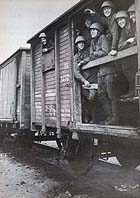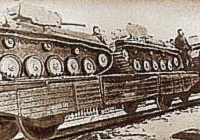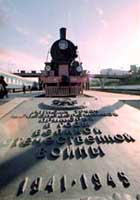Railways during the war

To successfully achieve the objectives had to rebuild on a war footing the entire complex railway complex. The beginning of this restructuring was the translation movement of trains on the special military plot, which was introduced by order of the People's Commissariat of Railways (People's Commissariat) June 22, 1941. He called for the promotion of primarily military trains and cargo-related transportation mobilization.

For rapid advance evakoeshelonov railroad widely used technical innovations used advanced methods of work: the formation of high-speed trains, bezottsepochny repairing, driving heavy trains, sending twin trains. In order to increase the capacity of certain sections of railway in autumn 1941 was introduced "live lock" - every 800-900 meters on stages were Signalist and their signals were trains. Changed work schedules locomotive crews. Before the war locomotive brigade usually drove trains in a particular area (shoulder), in time of war to the composition Crew car attached to the locomotive crew, and she led the train to your destination. Train drivers drove trains thousands of miles away, for months without returning home.

Railway workers to provide training and conduct more than 50 strategic and offensive operations carried out by the Soviet Armed Forces during World War II. The success of these operations, to facilitate the timely delivery of the hinterland of ammunition, fuel, food and other resources. The total volume of traffic during the preparation of the decisive battles reached 1 mln. Tons.
In addition to military tasks, the railways had to keep a continuous supply of industrial raw materials, fuel, metals and other essential goods, as well as to passengers. Thanks to the dedicated work of railway workers during the war, managed to tie the most important economic areas in the rear of a giant in the territory economic complex.
Before the start of the great turning point in 1943, after which it became clear outcome of the war, the railroad took part in the fighting, so there have been personnel exposure of the railway. Place on drivers, firemen and other professionals came youth, teens. In 1943 there was an order of Stalin for the return of all railway employees to their former place of work. This helped to strengthen the staff of the railways, which, in turn, improved the quality of freight.
Facts and Figures wartime

in 1941 - 93%;
in 1942 - 52%;
in 1943 - 58%;
1944 - 68%;
1945 - 76%.
Transported 20 million cars with soldiers, ammunition, military equipment, food. If you build these echelons of the chain, then they can be the whole earth 4 times to wrap around the equator. Trains were a continuous stream, sometimes the interval is 600-700 meters.
During the defensive battles near Moscow under military shipments were received 333.5 thousand. Cars.
In preparation for the Battle of Kursk 14,410 trains moved armies at full strength.
2.5 thousand. Factories were evacuated to the Urals. This will reduce the time to restore the military and industrial potential.
In the evacuation were taken 18 million people. It took more than 1.5 million cars.
From June to December 1941 on the front-line railways objects Luftwaffe flew about 6 thousand. Air raids. During the war, was destroyed 16 thousand. Locomotives.
In wartime, the railroad restored 120 thousand. Km of railways, 13 thousand. Small and about 3 thousand. Large bridges.
During the war, the proportion of young people (under 25) in rail transport accounted for 32% (including a locomotive service - 34.3%, in the car - 39.3%).
